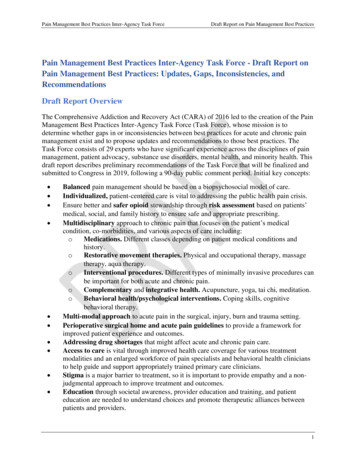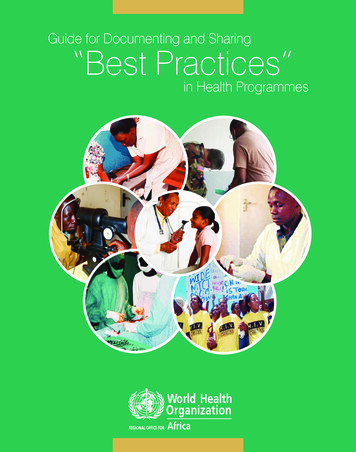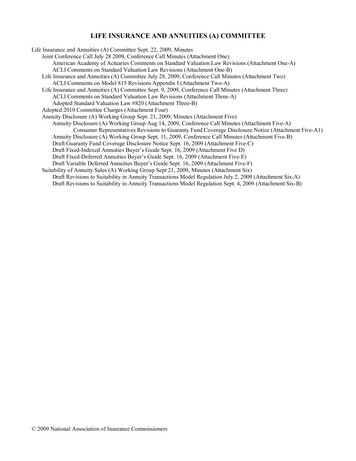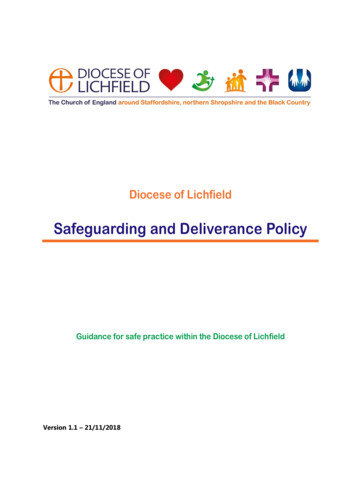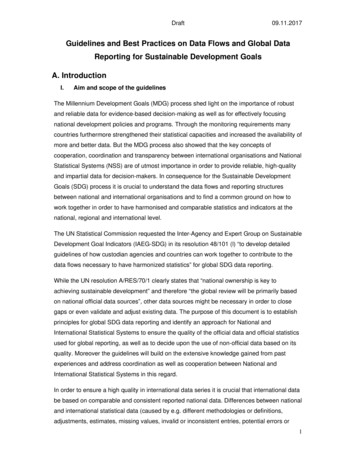
Transcription
Draft09.11.2017Guidelines and Best Practices on Data Flows and Global DataReporting for Sustainable Development GoalsA. IntroductionI.Aim and scope of the guidelinesThe Millennium Development Goals (MDG) process shed light on the importance of robustand reliable data for evidence-based decision-making as well as for effectively focusingnational development policies and programs. Through the monitoring requirements manycountries furthermore strengthened their statistical capacities and increased the availability ofmore and better data. But the MDG process also showed that the key concepts ofcooperation, coordination and transparency between international organisations and NationalStatistical Systems (NSS) are of utmost importance in order to provide reliable, high-qualityand impartial data for decision-makers. In consequence for the Sustainable DevelopmentGoals (SDG) process it is crucial to understand the data flows and reporting structuresbetween national and international organisations and to find a common ground on how towork together in order to have harmonised and comparable statistics and indicators at thenational, regional and international level.The UN Statistical Commission requested the Inter-Agency and Expert Group on SustainableDevelopment Goal Indicators (IAEG-SDG) in its resolution 48/101 (l) “to develop detailedguidelines of how custodian agencies and countries can work together to contribute to thedata flows necessary to have harmonized statistics” for global SDG data reporting.While the UN resolution A/RES/70/1 clearly states that “national ownership is key toachieving sustainable development” and therefore “the global review will be primarily basedon national official data sources”, other data sources might be necessary in order to closegaps or even validate and adjust existing data. The purpose of this document is to establishprinciples for global SDG data reporting and identify an approach for National andInternational Statistical Systems to ensure the quality of the official data and official statisticsused for global reporting, as well as to decide upon the use of non-official data based on itsquality. Moreover the guidelines will build on the extensive knowledge gained from pastexperiences and address coordination as well as cooperation between National andInternational Statistical Systems in this regard.In order to ensure a high quality in international data series it is crucial that international databe based on comparable and consistent reported national data. Differences between nationaland international statistical data (caused by e.g. different methodologies or definitions,adjustments, estimates, missing values, invalid or inconsistent entries, potential errors or1
Draft09.11.2017other methodological as well as conceptual issues) do not only cause confusion, but can alsodamage the credibility of statistical agencies. They also can result in major discrepanciesbetween organisations. Therefore the focus should be on a consistent and coordinatedapproach for processing data and metadata particularly with regards to validation andediting. This means clearly elaborated data flows are necessary to enhance coordinationbetween National and International Statistical Systems. Equally important is the necessity toidentify ways to deal with and communicate adjustments and estimations undertaken byorganisations reporting on SDGs.II.ProvisionsThe adoption of the General Assembly (GA) resolution A/RES/70/1 “Transforming ourworld: the 2030 Agenda for Sustainable Development” was a bold step anddemonstrates the necessity to shift the world towards a sustainable development, in allits dimensions. With this resolution the international community also committed to afollow-up and review process at the national, regional and international level in order tomonitor the progress made in implementing the Sustainable Development Goals andtargets over the coming years.In its resolution A/RES/71/313 the GA instructed the UN Statistical Commission(StatCom) with several tasks. Some of the tasks given to the StatCom include, “tocoordinate the substantive and technical work to develop international statisticalstandards, methods and guidelines, where necessary [ ]” and “through the InterAgency and Expert Group on Sustainable Development Goal Indicators, to further refineand improve the global indicator framework in order to address coverage, alignment withtargets, definition of terms and development of metadata and to facilitate itsimplementation [ ]” (A/RES/71/313 para. 3).Since taking ownership is key for this transformation at all levels, member states play thecentral role in the Agenda 2030 process. This also means that individual nationalrealities, capacities and policy priorities with regards to the follow-up and review processwill have to be respected (A/RES/70/1 para. 74). At the same time the GA emphasisesthe importance of a strong and revitalised global partnership, which “brings togetherGovernments, the private sector, civil society, the United Nations system and otheractors” (A/RES/70/1 para. 39).2
Draft09.11.2017As the global review is to be primarily based on national official data sources, the GAstresses that National Statistical Offices (NSO) hold a coordinating role in the NationalStatistical Systems (A/RES/71/313 para. 6).A critical aspect for the achievement of the Agenda 2030 goals is to make high-qualityofficial statistical information available. Therefore, all levels and stakeholders that arepart of the global statistical system have to adhere to the Fundamental Principles ofOfficial Statistics, endorsed by the GA in its resolution A/RES/68/261 of 29 January2014. This was again stressed in resolution A/RES/71/313, stating “that all activities ofthe global statistical system must be conducted in full adherence to the FundamentalPrinciples of Official Statistics” (A/RES/71/313 para. 8).In this context the Generic National Quality Assurance Framework template, which wasfully endorsed by the StatCom in its forty-third session in 2012, gives guidance onensuring these quality demands. With respect to the National Quality AssuranceFrameworks template and guidelines, the Expert Group on National Quality AssuranceFramework was assigned the task to update the template and guidelines.Regarding the production of high-quality data the GA also recalled the Economic andSocial Council (ECOSOC) resolution 2006/6. The ECOSOC states that imputation by allinternational agencies should be avoided “unless specific country data are available forreliable imputations following consultations with concerned countries and throughtransparent methodologies” (ECOSOC Resolution 2006/6 para. 5c).The monitoring process for the MDGs illustrated that the differences between nationallyreported data and international disseminated data “can be considerably large” (UNECE;2011). Reasons behind these differences include the use of different primary datasources, the operations of data revision and adjustments or different time coverages byinternational and national agencies. For the SDGs the GA therefore put on record thatthe follow-up and review process should primarily be based on data produced byNational Statistical Systems. In cases where specific country data are not available,international agencies are urged to consult with the concerned countries beforepublishing own estimations, in order to make harmonised data available (A/RES/71/313para. 7). The StatCom also recommendes that in cases where country data are adjustedor estimated, this should be done in full consultation with the concerned country(StatCom 48/101 para. l). The involvement of the concerned country is also highlightedin the report of the Secretary-General on “Quality assurance in the global statisticalsystem” to the 48th Session of the StatCom.3
Draft09.11.2017Furthermore, international agencies are urged to enhance communication andcoordination amongst each other “in order to avoid duplicate reports, ensure consistencyof data and reduce response burdens on countries” as well as “provide themethodologies used to harmonise country data for international comparability andproduce estimates through transparent mechanisms” (A/RES/71/313 para. 7). Thisnecessity is also reinforced in a statement by the Secretary-General (E/CN.3/2017/8).The StatCom also decided that when other sources and methodologies are used thesewill be reviewed and agreed by national statistical authorities and presented in atransparent manner (48/101 (l)).The StatCom further requested the custodian agencies to provide “a list of nationalagencies providing the data to the international system and share data collectioncalendars in order to ensure the full traceability of data used in international sources”(48/101 (k)).Finally, the report “A world that counts” elaborates nine key principles for the datarevolution for sustainable development. As a part of these, the report underlines thenecessity of periodic audits by professional and independent third parties in order todemonstrate the high quality and integrity of statistical information, especially in the lightof non-traditional data sources such as big and geospatial data (Independent ExpertAdvisory Group on a Data Revolution for Sustainable Development, 2014).B. Guidelines for Global SDG Data ReportingI.Principles to guide data reporting from National to International StatisticalSystems and data sharing for SDG indicators1.Definitions:a) ‘official data’ refers to a set of values of qualitative or quantitative variables,which are produced and / or disseminated by an official source such as theNational Statistical Office or another governmental agency or departmentincluding non-traditional types of data.b) ‘official statistics’ means a part of official data, which is produced incompliance with Fundamental Principles of Official Statistics.2.All organisations that are involved in the global follow-up and review process of SDGs,including national statistics offices, other government departments, and internationalorganizations are committed to:4
Draft09.11.2017a) Basing the global review primarily on national official data,b) Acknowledging the coordinating role of National Statistical Offices in theNational Statistical Systems,c) Promoting the use of an appropriate data transmission standard, such asStatistical Data and Metadata eXchange (SDMX), for the collection andexchange of SDG data,d) Providing metadata according to scientific standards on the sources, methodsand procedures of the statistics,e) Using national SDG indicator reporting platforms where available and take intoaccount already well-established data reporting mechanisms. While NationalStatistical Systems are committed to timely dissemination of national officialdata, via a national reporting platform if available, custodian agencies arecommitted to retrieving the official data from those same reporting platforms. Ifno official data is available in the national reporting platform and there is noother well-established data reporting mechanism, the custodian agency willcheck with the National Statistical Office to determine official data availability,f) If no national SDG indicator reporting platform is available and there is noother well-established data reporting mechanism, the National StatisticalOffice and the custodian agency determine together a data flow model.Countries may choose to declare regional database as primary source forcustodian agencies to retrieve country data,g) Establishing a common timetable for data reporting of National StatisticalSystems, including timeframes for technical consultations and accreditationprocedures, while coordinating and arranging data requests and technicalconsultations in a workable timely manner,h) Determining one custodian agency responsible for each SDG indicator and acontact point in the corresponding agency. This list will be disclosed to theNational Statistical Office [by UNSD] [by the end of 2017],i) Contacting and communicating with the National Statistical Systems vianational focal points preferably from the National Statistical Office taking intoaccount already well-established data reporting mechanisms. In case no focalpoint is identified, the National Statistical Office will be considered the focal5
Draft09.11.2017point. Furthermore the NSO is either copied in all SDG data requests orprovided with a list of all national data providers by custodian agencies,j) In cases, where the SDG indicators are used by custodian agencies as well aspartner agencies in thematically connected publications and databases theidentical data sets from the global SDG database provided by the NationalStatistical System are to be used,k) Coordinating their data collection work and establish effective and efficientdata sharing arrangements among custodian agencies to avoid duplication ofefforts. Data provided to the custodian agencies by the NSS shall only beshared after quality assurance and the plausibility check are carried out andfinished in order to ensure consistency of data,l) Coordinating updates on UN databases to ensure consistency of data.3.A guiding principle for National and International Statistical Systems which are involvedwith the global SDGs data flow and reporting is to ensure a high quality of statisticalinformation.4.The high quality of official data disseminated in international statistics shall be ensuredby:a) Promoting the use of international standards for data in accordance with theUN Classifications Registry or other standards adopted by the UN StatisticalCommission, selecting the most appropriate statistical methods and datasources exclusively on the basis of scientific and statistically robustconsiderations as well as a transparent documentation, andb) Having in place:(i)laws or guidelines applicable in the area of quality assurance,(ii) monitoring systems,(iii) enforcement systems, andc) A mandatory quality assessment of the data set carried out by the responsiblecustodian agency and consisting of a set of tools spelled out in the Guidelinesfor the Template for a Generic National Quality Assurance Framework. Basedon this quality assessment the decision about the use of a data set for globalSDG data reporting shall be:6
Draft(i)09.11.2017in case of official data, in consensus with the national official dataprovider as well as the National Statistical Office, and(ii) in case of official statistics consensual with the National StatisticalOffice.In case of non-response from the national official data provider or the NationalStatistical Office, the custodian agency may understand this as if thecorresponding entity had expressed their consent. This only applies if thecontact information used to send the request had been previously validated,and there is no response following two subsequent requests with reasonabletimeframes.5.The quality of non-official data disseminated in international statistics shall be ensuredby:a) Promoting the use of international standards for data in accordance with theUN Classifications Registry, selecting the most appropriate statistical methodsand data sources exclusively on the basis of scientific and statistically robustconsiderations as well as a transparent documentation, andb) Having in place:(i)laws or guidelines applicable in the area of quality assurance,(ii) monitoring systems,(iii) enforcement systems, andc) An accreditation procedure1 for non-official data by custodian agencies whichincludes a consultation with all involved parties as specified in Annex 1. TheNational Statistical Office may carry out the accreditation procedure if theywish to. The decision whether to utilise the data set and for which purposesshall be based on this accreditation procedure and taken in consensus withthe listed national focal point and the National Statistical Office. The NationalStatistical Office should also be involved during the different steps of theaccreditation procedure.d) In cases where specific national official data is not available and custodianagencies or other international agencies estimate or model country data the1Estimates or modelled data from non-official sources will be substituted, when / if national official data becomesavailable and following the mandatory quality assessment as outlined in Article 4 para. c.7
Draft09.11.2017same accreditation procedure applies as for non-official data. The decisionwhether to utilise the estimates or modelled data and for which purposes shallbe taken in consensus with the listed national focal point and the NationalStatistical Office.e) In case of non-response from the national focal point or the National StatisticalOffice to the accreditation procedure, the custodian agency may understandthis as if the corresponding entity had expressed their consent. This onlyapplies if the contact information used to send the request had beenpreviously validated, and there is no response following two subsequentrequests with reasonable timeframes.II.Principles to guide the production of international data series for SDGindicators(1)6.Concerning DataWhen a plausibility check such as specified in Annex 2 identifies missing values orinvalid or inconsistent entries or potential errors or data gaps and makes it necessary forthe custodian agency to adjust, including through imputation, these country data thefollowing procedure2 shall apply:a) The custodian agency generates a list of potential errors as a starting point forthe adjustment process.b) The custodian agency selects the most appropriate statistical methods anddata sources exclusively on the basis of scientific and statistically robustconsiderations as for example referred to in Practical Guide on Data Validationand Editing, in order to calculate the adjusted values. The adjusted values areadded to the list of potential errors, in order to compare them. The list ofpotential errors, the adjusted values and the chosen methodological approachshall be disclosed to the National Statistical Office and the national officialdata provider. Furthermore the chosen methodological approach shall bedisclosed to anyone upon request.c) In case of official data, the custodian agency invites the listed national officialdata provider to participate in a joint technical consultation via conference call,2This procedure does not apply to standard practices of conversion to common measurement units.8
Draft09.11.2017electronic means or physical meetings with the aim to improve and validatethe adjusted values as well as the used method.d) In case of official statistics, the custodian agency invites the NationalStatistical Office to participate in a joint technical consultation via conferencecall, electronic means or physical meetings with the aim to improve andvalidate the adjusted values as well as the used method.e) In case of non-official data3, the custodian agency invites the listed nationalfocal point, the National Statistical Office as well as the data set provider toparticipate in a joint technical consultation via conference call, electronicmeans or physical meetings with the aim to improve and validate the adjustedvalues as well as the used method.f) The custodian agency ensures a reasonable timeframe for the NationalStatistical System and data providers to respond, but at least two weeksminimum. In case of non-response from the National Statistical System ordata providers, the custodian agency may understand this as if thecorresponding entity had expressed their consent. This only applies if thecontact information used to send the request had been previously validated,and there is no response following two subsequent requests with reasonabletimeframes.g) The solution agreed upon will be adopted and published in the global SDGdatabase and all thematically connected international publications in order toavoid discrepancies.7.If in the case of missing values or invalid or inconsistent entries or potential errors ordata gaps no agreement is found during the technical consultation according to Article 6para. c - e the country data requiring adjustment shall be:(i)disseminated alongside the estimates from the custodian agencyaccompanied by an explanation of the reasons for the discrepancy andthe chosen methodologies by the concerned parties.(ii) If both parties wish so, the concerned United Nations regionalcommission can be called upon to reach a regional solution on thesubject matter.3 According to Article 5 para. c the decision to utilise non-official data shall be taken in consensus with the nationalofficial focal point and the NSO.9
Draft8.09.11.2017When during a plausibility check, such as specified in Annex 2, issues such asmethodological gaps as well as conceptual issues and differences in the metadata as forexample between nationally and internationally used standards or because of changesof standards over time are found and these make it necessary for the custodian agencyto adjust data, the following procedure shall be undertaken:a) A list is to be generated on these differences as starting point for theadjustment process of the data.b) The custodian agency selects the most appropriate statistical methodsexclusively on the basis of scientific and statistically robust considerations asfor example referred to in Practical Guide on Data Validation and Editing, inorder to calculate the adjusted values. The adjusted values are added to thelist of differences, in order to compare them. Besides the list of differences andthe adjusted values, the chosen methodological approach shall be disclosedto the National Statistical Office, the national official data provider and anyoneupon request.c) In case of official data, the custodian agency invites the listed national officialdata provider to participate in a joint technical consultation via conference call,electronic means or physical meetings with the aim to validate the adjustedvalues as well as the used method.d) In case of official statistics, the custodian agency invites the NationalStatistical Office to participate in a joint technical consultation via conferencecall, electronic means or physical meetings with the aim to validate theadjusted values as well as the used method.e) In case of non-official data4, the custodian agency invites the listed nationalfocal point, the National Statistical Office as well as the data set provider toparticipate in a joint technical consultation via conference call, electronicmeans or physical meetings with the aim to validate the adjusted values aswell as the used method.f) The custodian agency ensures a reasonable timeframe for the NationalStatistical System and data providers to respond, but at least two weeksminimum. In case of non-response from the National Statistical System ordata providers, the custodian agency may understand this as if the4 According to Article 5 para. c the decision to utilise non-official data shall be taken in consensus with the nationalofficial focal point and the NSO.10
Draft09.11.2017corresponding entity had expressed their consent. This only applies if thecontact information used to send the request had been previously validated,and there is no response following two subsequent requests with reasonabletimeframes.g) The solution agreed upon will be adopted and published in the global SDGdatabase and all thematically connected international publications, in order toavoid discrepancies.9.If no agreement is found during the technical consultation according to Article 8 para. a-gthe country data requiring adjustment shall be:(i)disseminated alongside the adjusted data from the custodian agencyaccompanied by an explanation of the reasons for the discrepancy andthe chosen methodologies by the concerned parties.(ii) If both parties wish so, the concerned United Nations regionalcommission will be called upon to reach a regional solution on thesubject matter.(2)Concerning Metadata10. For the National Statistical System to provide accurate and internationally comparabledata to the custodian agencies, these have to provide detailed information regardinginter alia definitions, classifications, methods of computation. The needed information isdefined in the IAEG-SDGs Template for Metadata Sustainable Development Goals.11. The IAEG-SDG can appeal to the custodian agencies to revise their correspondingmetadata and give guidance on needed revisions as specified under Article 12. Further,the IAEG can ask international expert groups as for example the Expert Group onInternational Statistical Classifications or city groups to provide guidance on neededrevisions of metadata. Pending the revision and the approval of the new metadata by theIAEG-SDG the corresponding indicator and all time series in question are marked as“content under review” in the global SDG database.12. Revisions of metadata are inter alia required when:a) the metadata provided by the custodian agency does not include all thenecessary information as defined in the IAEG-SDGs Template for MetadataSustainable Development Goals, or11
Draft09.11.2017b) the metadata provided by the custodian agency does not correspond to theindicator or changes the meaning of the indicator, orc) the international standard provided in the metadata by the custodian agency isneither widely accepted nor internationally established, ord) The methods (i.e. method of computation, calculation of aggregates) providedin the metadata by the custodian agency are not internationally established ordo not meet statistical standards regarding inter alia soundness andtransparency.13. In case a national data provider finds that the metadata provided by the custodianagency lacks information needed to make national data available or other entities findthat the metadata provided by the custodian agency lacks information necessary tounderstand the data provided in the global database, said entities contact theresponsible custodian agency. If no agreement can be found in a consultation betweenthe involved parties the Inter-Agency and Expert Group on Sustainable DevelopmentGoal Indicators will be called upon.14. For the custodian agency to be able to carry out the plausibility check, metadata fromnational data providers are necessary. In cases where no metadata is made available bythe national data provider or the metadata provided does no not include the necessaryinformation as for example stated in the Template for Metadata SustainableDevelopment Goals, the custodian agency will contact the national data provider with therequest to provide the necessary metadata within a reasonable timeframe. If nometadata is provided to the responsible custodian agency by the national data providerin the set timeframe and following two subsequent reminders of the request, thecustodian agency may decide to not utilise the corresponding data.15. Technical assistance may be provided to countries in areas where data are notavailable, of low quality or differ due to different methodologies and definitions, in orderto strengthen national data systems and therefore enable them to produce their owndata in the long run.12
Draft09.11.2017AnnexAnnex 1: Accreditation Procedure for Non-Official Data (based on “Accreditationprocedure for statistical data from non-official sources”)1.Phase 1: Initial examination of sources, data, and metadataa) Collection of all freely available informationb) Circulation of the collected information internallyc) Examination of the information with a focus on usefulness2.Phase 2: Acquisition of data and assessmenta) Closer cooperation with the data provider to acquire essential information suchas data set segments, time and methodb) Update the results of phase 1c) Make a first appropriate recommendation, inform the National Statistical Officei.a. including a report on the methodology and provide the possibility tocomment3.Phase 3: Forensic investigationa) Producing a clean microdata fileb) Produce and analyse aggregated statisticsc) Producing pilot outputs or using the file in the production of existing outputd) Assessing the capacity of the existing statistical tools to handle the new datae) Assess the strengths and weaknesses of the new data4.Phase 4: Decisiona) Itemisation of the exact uses of the new data and their impactb) Conduct a cost-benefit analysisc) Assess riskd) Assessment of the feasibility from a legislative and socio-political point of viewe) Invite the concerned National Statistical Office, the possibly involved nationalfocal point as well as the data set provider to participate in a joint consultationwith the aim to find a consensual agreement.5.Phase 5: Formal Agreement with the data provider (e.g. a Memorandum ofUnderstanding)a) Secure cooperation and arrive at a formal and comprehensive agreementb) Articulate governance, including change management13
Draft09.11.2017Annex 2: Plausibility Checklist (based on “Practical Guide on Data Validation andEditing”)1.Checking the data format.2.Checking for incomplete data, e.g. missing data.3.Checking the classification the indicator is based on.4.Detection of differences between definitions in national and international statistics.5.Checking for changes in the definitions and classifications used such as concepts,methodologies, surveyed population, data processing over time.6.Detection of non-admissible values.7.Detection of incoherencies among variables, i.e. are there relationships and restrictionsamong variables that have to be satisfied?8.Detection of large differences between the country’s current and past values.9.Search for breaks in the series, i.e. large jumps or differences in the data from oneperiod to the next.10. Search for large changes in the series length i.e. the number of observations in a dataseries supplied by a Member State suffers an important change.11. Check that aggregated items correspond to the sum of sub-items – when the countryprovides the breakdown of a given data, the tot
of non-traditional data sources such as big and geospatial data (Independent Expert Advisory Group on a Data Revolution for Sustainable Development, 2014). B. Guidelines for Global SDG Data Reporting I. Principles to guide data reporting from National to International Statistical Systems and data sharing for SDG indicators 1. Definitions:



